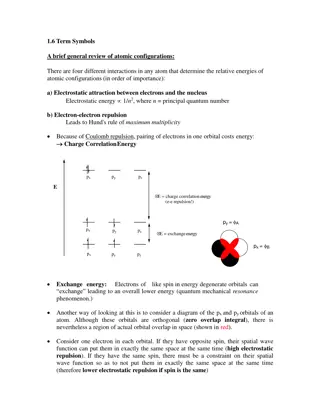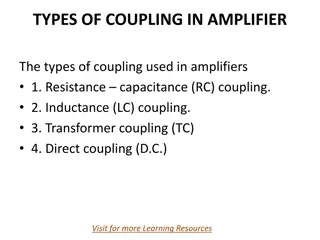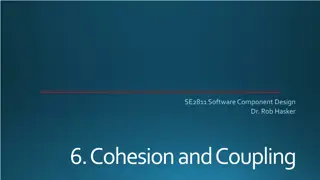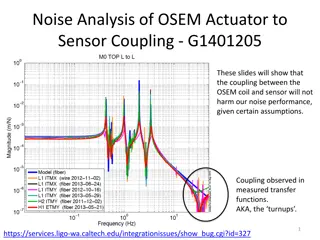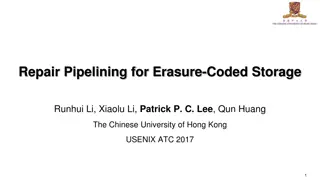Coupling Decentralized Key-Value Stores with Erasure Coding
Decentralized key-value stores leverage erasure coding for improved redundancy and fault tolerance, reducing redundancy overhead compared to traditional replication methods. Learn about the application of erasure coding in distributed KV stores, with a focus on scalability and fault tolerance using cross-coding approaches.
Download Presentation

Please find below an Image/Link to download the presentation.
The content on the website is provided AS IS for your information and personal use only. It may not be sold, licensed, or shared on other websites without obtaining consent from the author.If you encounter any issues during the download, it is possible that the publisher has removed the file from their server.
You are allowed to download the files provided on this website for personal or commercial use, subject to the condition that they are used lawfully. All files are the property of their respective owners.
The content on the website is provided AS IS for your information and personal use only. It may not be sold, licensed, or shared on other websites without obtaining consent from the author.
E N D
Presentation Transcript
Coupling Decentralized Key-Value Stores with Erasure Coding Liangfeng Cheng1, Yuchong Hu1, Patrick P. C. Lee2 1Huazhong University of Science and Technology 2The Chinese University of Hong Kong SoCC 2019 1
Introduction Decentralized key-value (KV) stores are widely deployed Map each KV object deterministically to a node that stores the object via hashing in a decentralized manner (i.e., no centralized lookups) e.g., Dynamo, Cassandra, Memcached Requirements Availability: data remains accessible under failures Scalability: nodes can be added or removed dynamically 2
Erasure Coding Replication is traditionally adopted for availability e.g., Dynamo, Cassandra Drawback: high redundancy overhead Erasure coding is a promising low-cost redundancy technique Minimum data redundancy via data encoding Higher reliability with same storage redundancy than replication e.g., Azure reduces redundancy from 3x (replication) to 1.33x (erasure coding) PBs saving How to apply erasure coding in decentralized KV stores? 3
Erasure Coding Divide file data to k equal-sizedata chunks Encode k data chunks to n-k equal-size parity chunks Distribute the n erasure-coded chunks (stripe) to n nodes Fault-tolerance: any k out of n chunks can recover file data Nodes A B C D A B C D A B C D divide encode File A+C B+D A+D B+C+D A+C B+D A+D B+C+D (n, k) = (4, 2) 4
Erasure Coding Two coding approaches Self-coding: divides an object into data chunks Cross-coding: combines multiple objects into a data chunk Cross-coding is more appropriate for decentralized KV stores Suitable for small objects e.g., small objects dominate in practical KV workloads [Sigmetrics 12] Direct access to objects 5
Scalability Scaling is a frequent operation for storage elasticity Scale-out (add nodes) and scale-in (remove nodes) Consistent hashing Efficient, deterministic object-to-node mapping scheme A node is mapped to multiple virtual nodes on a hash ring for load balancing Add N4 6
Scalability Challenges Replication / self-coding for consistent hashing Replicas / coded chunks are stored after first node in clockwise direction Cross-coding + consistent hashing? Parity updates Impaired degraded reads 7
Challenge 1 Add N4 Data chunk updates parity chunk update Frequent scaling huge amount of data transfers (scaling traffic) 8
Challenge 2 N1 fail ab c d Read to d fails until d is migrated N2 dh N4 e f gh fail Degraded read to d doesn t work if h is migrated away from N2 parity N3 success Coordinating object migration and parity updates is challenging due to changes of multiple chunks Degraded reads are impaired if objects are in middle of migration 9
Contributions New erasure coding model: FragEC Fragmented chunks no parity updates Consistent hashing on multiple hash rings Efficient degraded reads Fragmented node-repair for fast recovery ECHash prototype built on memcached Scaling throughput: 8.3x (local) and 5.2x (AWS) Degraded read latency reduction: 81.1% (local) and 89.0% (AWS) 10
Insight A coding unit is much smaller than a chunk e.g., coding unit size ~ 1 byte; chunk size ~ 4 KiB Coding units at the same offset are encoded together in erasure coding Coding units at the same offset are encoded together Coding unit n chunks of a stripe Repair pipelining for erasure-coded storage , USENIX ATC 2017 11
FragEC Allow mapping a data chunk to multiple nodes Each data chunk is fragmented to sub-chunks Decoupling tight chunk-to-node mappings no parity updates 12
FragEC OIRList lists all object references and offsets in each data chunk OIRList records how each data chunk is formed by objects, which can reside in different nodes 13
Scaling Traverse Object Index to identify the objects to be migrated Keep OIRList unchanged (i.e., object organization in each data chunk unchanged) No parity updates 14
Multiple Hash Rings Distribute a stripe across n hash rings Preserve consistent hashing design in each hash ring Stage node additions/removals to at most n-k chunk updates object availability via degraded reads 15
Node Repair Issue: How to repair a failed node with only sub-chunks? Decoding whole chunks is inefficient Fragment-repair: perform repair at a sub-chunk level Downloads: data2: b2, b3 data3: c3 parity Downloads: data2: b1, b2, b3, b4 data3: c1, c2, c3 parity Reduce repair traffic Fragment-repair Chunk-repair 16
ECHash Built on memcached In-memory KV storage 3,600 SLoC in C/C++ Intel ISA-L for coding Limitations: Consistency Degraded writes Metadata management in proxy 17
Evaluation Testbeds Local: Multiple 8-core machines over 10 GbE Cloud: 45 Memcached instances for nodes + Amazon EC2 instances for proxy and persistent database Workloads Modified YCSB workloads with different object sizes and read-write ratios Comparisons: ccMemcached: existing cross-coding design (e.g., Cocytus [FAST 16]) Preserve I/O performance compared to vanilla Memcached (no coding) See results in paper 18
Scaling Throughput in AWS Scale-out: (n, k, s), where n k = 2 and s = number of nodes added ECHash increases scale-out throughput by 5.2x 19
Degraded Reads in AWS Scale-out: (n, k) = (5, 3) and varying s ECHash reduces degraded read latency by up to 89% (s = 5) ccMemcached needs to query the persistent database for unavailable objects 20
Node Repair in AWS Scale-out: (n, k) = (5, 3) and varying s Fragment-repair significantly increases scaling throughput over chunk-repair, with slight throughput drop than ccMemcached 21
Conclusions How to deploy erasure coding in decentralized KV stores for small-size objects Contributions: FragEC, a new erasure coding model ECHash, a FragEC-based in-memory KV stores Extensive experiments on both local and AWS testbeds Prototype: https://github.com/yuchonghu/echash 22


